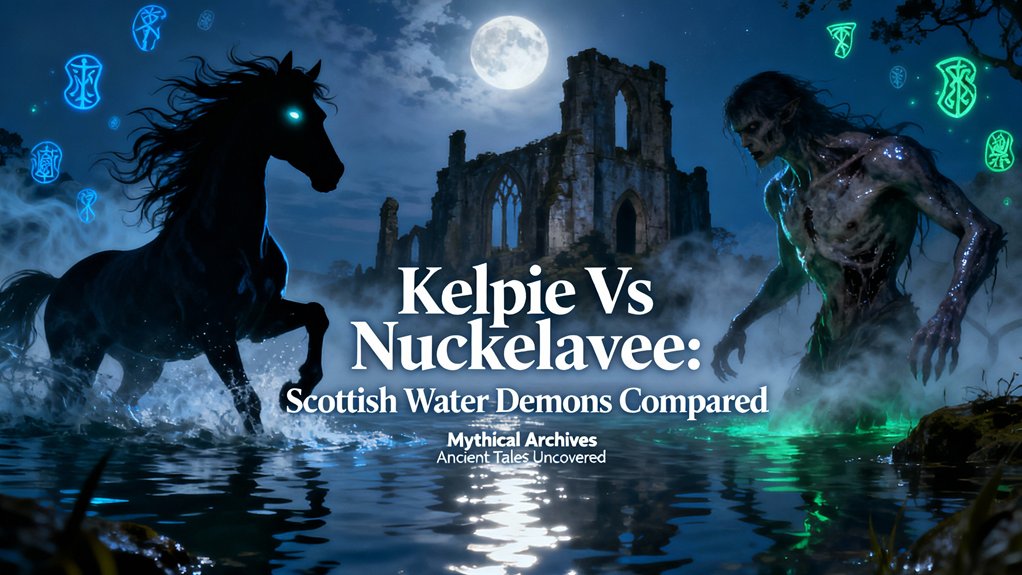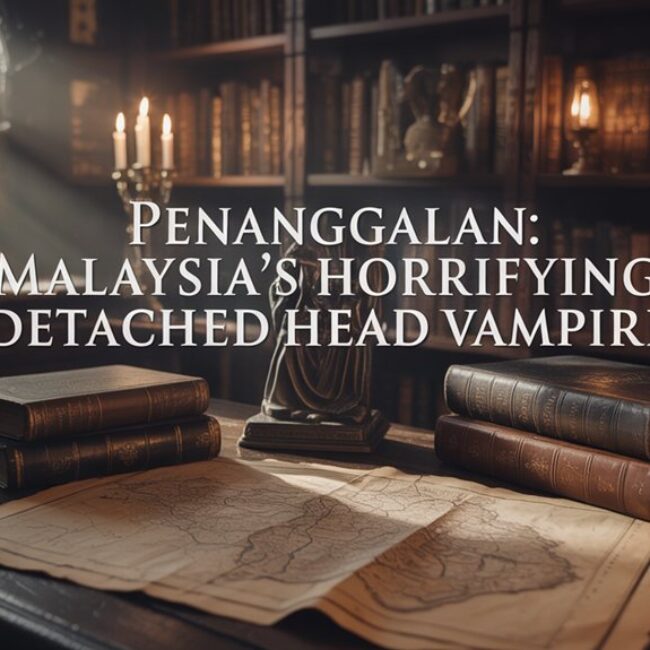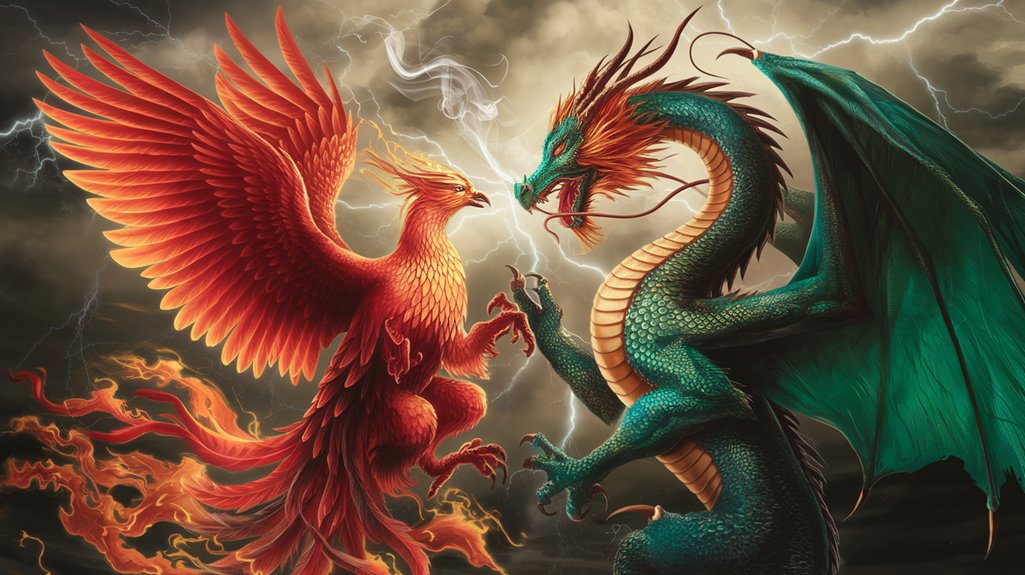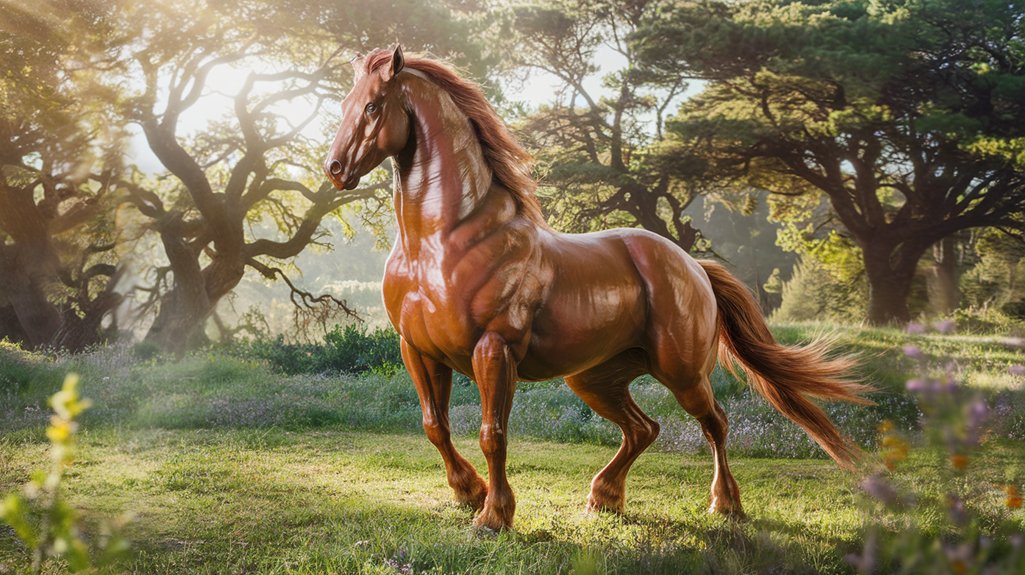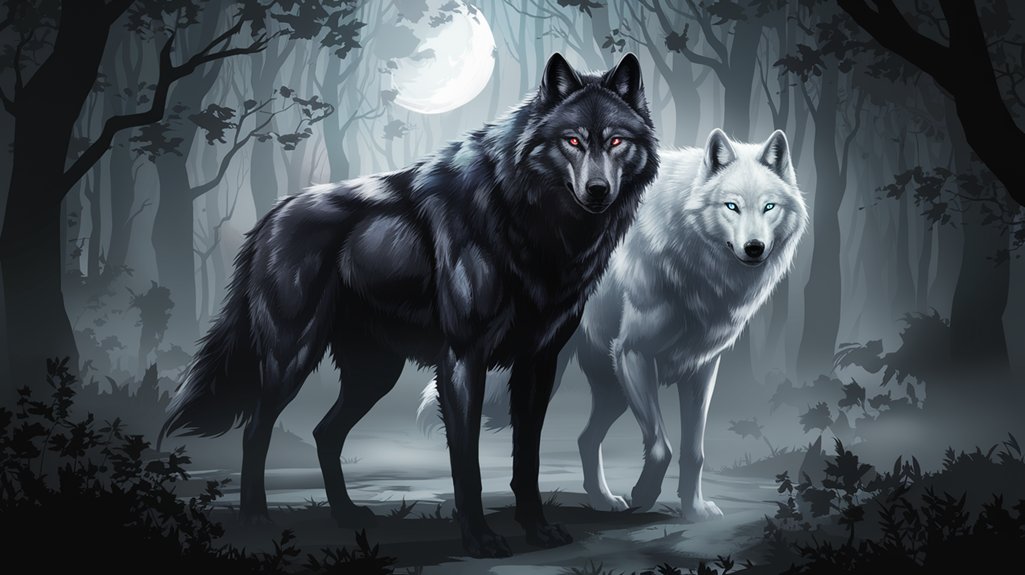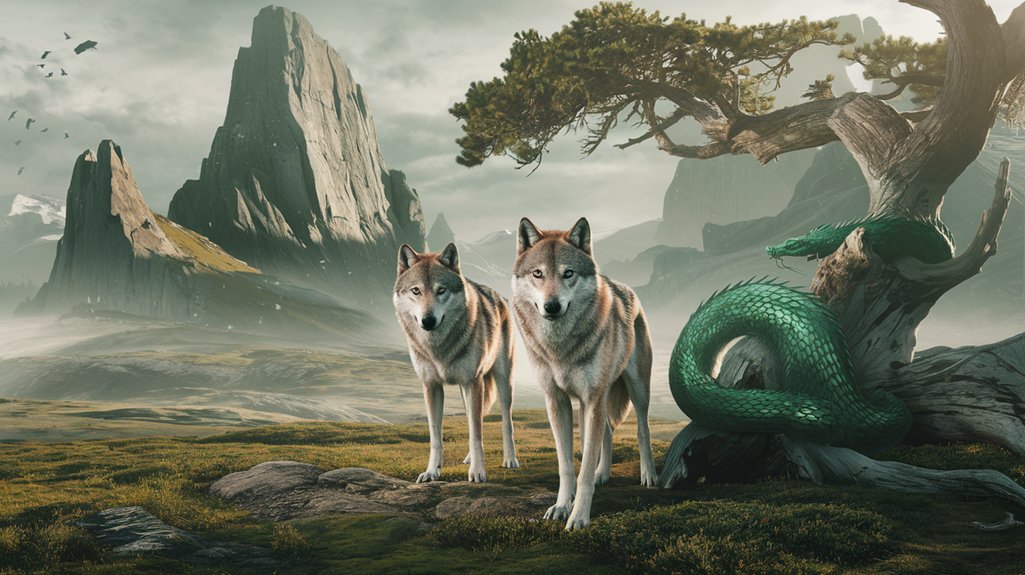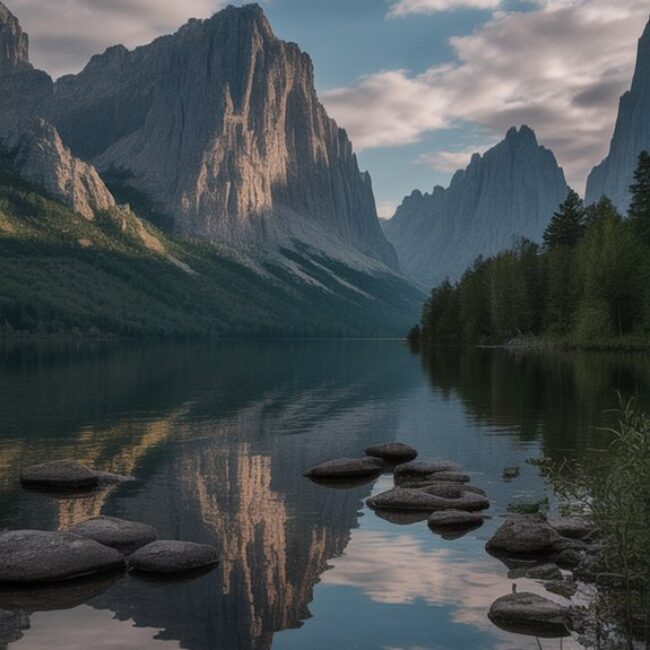You'll encounter two distinct manifestations of aquatic terror in Scottish waters: the kelpie, an obsidian shape-shifter inhabiting freshwater lochs since Celtic migrations (4th-6th centuries CE), employs seductive metamorphosis and adhesive flesh to drag victims into drowning depths, while Orkney's nuckelavee—a skinless, chimeric horror—stalks coastal margins in its fixed, pestilential form, spreading contagion through venomous breath and crushing hooves. Their contrasting methodologies—cunning deception versus unmasked devastation—reflect divergent evolutionary paths in supernatural taxonomy, each encoding specific environmental dangers and ancestral survival wisdom that extends far beyond these fundamental distinctions.
Key Takeaways
- Kelpies inhabit freshwater lochs and rivers as shapeshifting predators, while Nuckelavee haunts coastal waters as a fixed, skinless horror.
- Kelpies lure victims through seductive beauty and metamorphosis; Nuckelavee relies on pure terror and its grotesque, exposed-muscle appearance.
- Nuckelavee spreads disease, causing epidemics and crop blight through its breath; Kelpies function solely as individual predators without pathogenic abilities.
- Kelpies can be controlled via enchanted bridles; Nuckelavee is repelled by fresh water and constrained by invoking the Mither o' the Sea.
- Both creatures reflect regional environmental fears: Kelpies embody freshwater drowning dangers, while Nuckelavee represents coastal vulnerability and pestilence.
Origins and Regional Distribution in Scottish Folklore
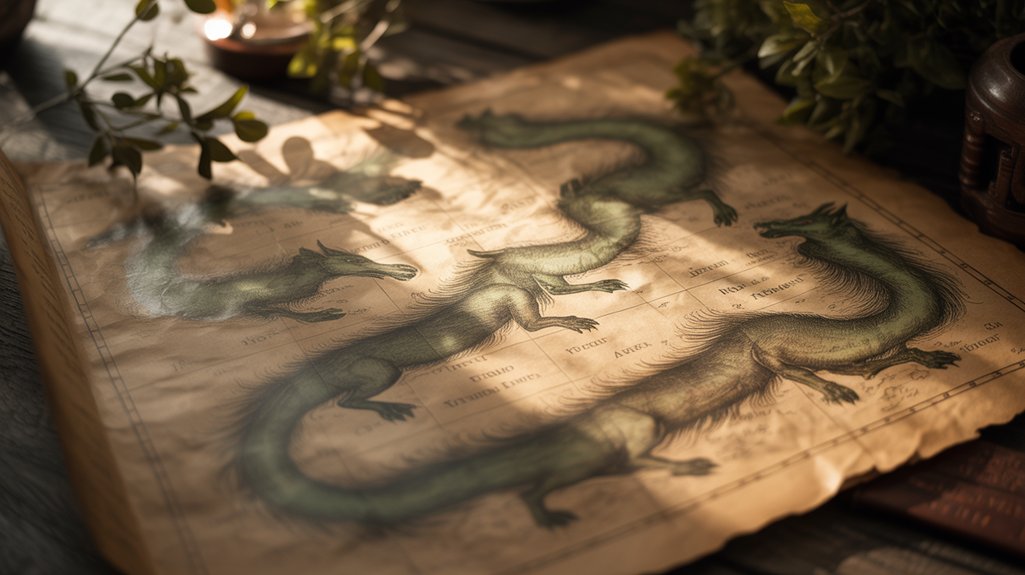
When the Celtic peoples settled Scotland's windswept coasts and misty highlands between the 4th and 6th centuries CE, they brought with them an ancient taxonomy of water spirits that would intermingle with indigenous Pictish beliefs, creating a uniquely Scottish pantheon of aquatic terrors.
🎯 Recommended Products
Handpicked items related to this article:
As an Amazon Associate, we earn from qualifying purchases.
You'll find the kelpie's origin stories woven throughout mainland Scotland's lochs and rivers, where these shape-shifting equine entities embodied the treacherous nature of freshwater crossings that claimed countless lives.
The nuckelavee emerged from Orcadian consciousness—a chimeric amalgamation of horse and rider fused into one skinless, eldritch abomination.
Regional variations reflect distinct environmental pressures: mainland communities feared drowning in deceptive river currents, while Orkney islanders faced something far more primal.
The nuckelavee represented coastal vulnerability itself—storms, crop blights, epidemic diseases.
These weren't merely cautionary tales. They were survival frameworks, teaching you to respect boundaries between human settlements and those liminal spaces where ancient powers still held dominion.
Physical Appearance and Distinctive Features
The kelpie materializes in Scottish testimony as an obsidian stallion of impossible beauty—sleek coat perpetually dripping with river water, eyes that gleam with predatory intelligence, mane tangled with pondweed and freshwater sedge. You'll recognize its aquatic features immediately: webbed hooves, phosphorescent skin beneath moonlight, the scent of deep lochs clinging to its form.
The nuckelavee presents chimeric horror incarnate—skinless, muscles exposed in glistening red sinew, veins pulsing visibly across its body. This eldritch abomination combines equine and humanoid elements without separation.
| Feature | Kelpie | Nuckelavee |
|---|---|---|
| Primary Form | Stallion (shapeshifts) | Horse-human fusion |
| Skin | Smooth, wet, intact | Raw, flayed, skinless |
| Mythical Characteristics | Seductive beauty | Pestilential terror |
| Aquatic Features | Freshwater essence | Saltwater origins |
You're confronting fundamentally different manifestations—the kelpie wears deception like silk, while the nuckelavee displays its monstrosity without pretense. Liberation from these creatures requires recognition.
Shape-Shifting Abilities and Transformations
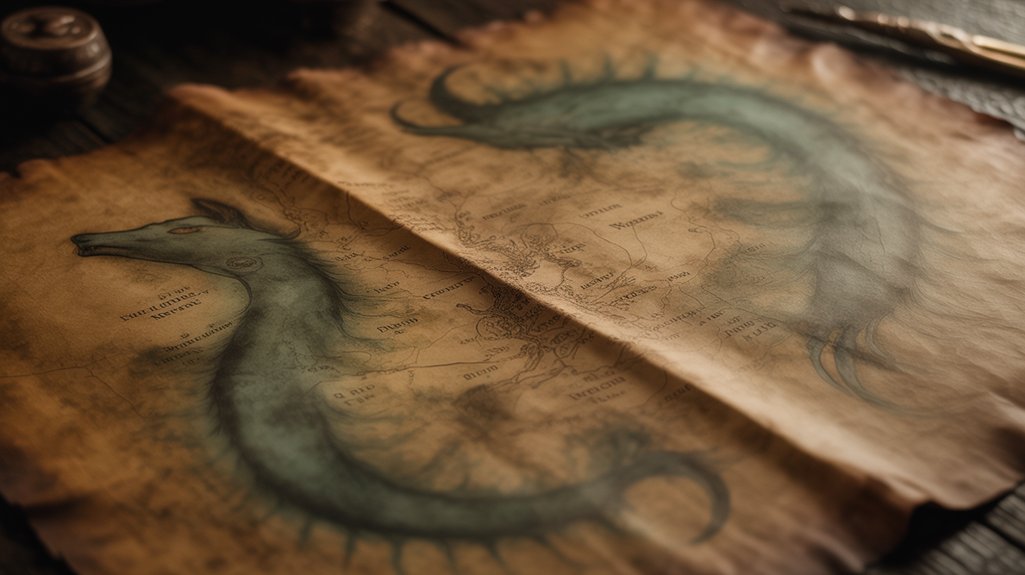
You'll find that the kelpie's metamorphic prowess stands in stark contrast to the nuckelavee's immutable horror—where one creature employs alteration as predatory strategy, the other relies upon its fixed, chimeric form to instill terror.
The kelpie shifts between equine beauty and eldritch nightmare, mastering the liminal threshold between attraction and revulsion, its skin changing from sleek horsehide to adhesive flesh that traps victims against its flanks.
The nuckelavee, however, manifests as an unchanging abomination: part horse, part rider, eternally fused in a skinless amalgamation that requires no disguise, for its very permanence embodies the raw, unfiltered malevolence of Orcadian waters.
Kelpie's Equine Disguise Forms
Throughout Scottish folklore's darkest waterways, kelpies manifest their most infamous form—that of a magnificent horse whose beauty serves as lethal bait for the unwary.
You'll find these creatures adopting sleek, muscular equine bodies, their coats gleaming like obsidian beneath moonlight, manes perpetually dripping with river water. The kelpie myths describe horses of impossible perfection, their appearances calibrated to human desire—sometimes midnight black, occasionally dappled grey, always irresistible.
This equine symbolism represents more than mere camouflage; it embodies Scotland's relationship with horses as both servants and dangerous forces. The kelpie's hide remains cold and clammy to touch, betraying its eldritch nature.
Once mounted, its adhesive flesh traps victims, rendering escape impossible as it plunges toward watery depths, converting beautiful promise into drowning terror.
Nuckelavee's Fixed Monstrous Appearance
Unlike its shape-shifting counterpart, the nuckelavee possesses no capacity for change, no merciful illusion to soften its nightmarish reality—it remains locked eternally within its singular, horrifying form.
You'll encounter nuckelavee traits that define absolute horror: skinless equine body fused with humanoid torso, black blood pulsing through exposed veins, yellow eyes burning with malevolent intelligence. This chimeric abomination emerged from Orcadian waters, its monstrous imagery seared into collective memory.
The creature's fixed nature embodies three terrifying truths:
- No escape through deception—what you see manifests your doom
- Unmasked malevolence—pure evil requiring no disguise
- Eternal imprisonment—bound within eldritch flesh, neither human nor beast
This permanence strips away hope.
The nuckelavee's inability to change represents freedom's antithesis—pure, unadulterated captivity within monstrous existence.
Comparative Transformation Tactics
When examining these creatures through the lens of metamorphic capability, the kelpie emerges as alteration's master while the nuckelavee stands imprisoned within its singular, grotesque manifestation—a dichotomy that reveals profound truths about predatory strategy and cosmological order. The kelpie's metamorphosis strategies embody adaptive intelligence, shifting between equine beauty and humanoid seduction. Creature psychology diverges sharply here.
| Aspect | Kelpie | Nuckelavee |
|---|---|---|
| Primary Form | Fluid, multiple options | Fixed chimeric horror |
| Deception Method | Active shape-shifting | Environmental ambush |
| Victim Approach | Calculated metamorphosis | Raw intimidation |
| Transformation Range | Horse, human, hybrid | None—eternally monstrous |
The nuckelavee's eldritch immutability represents chaos released, requiring no disguise. Pure terror suffices. This contrast illuminates fundamental freedoms: choice versus predetermined fate.
Primary Habitats and Territorial Behaviors
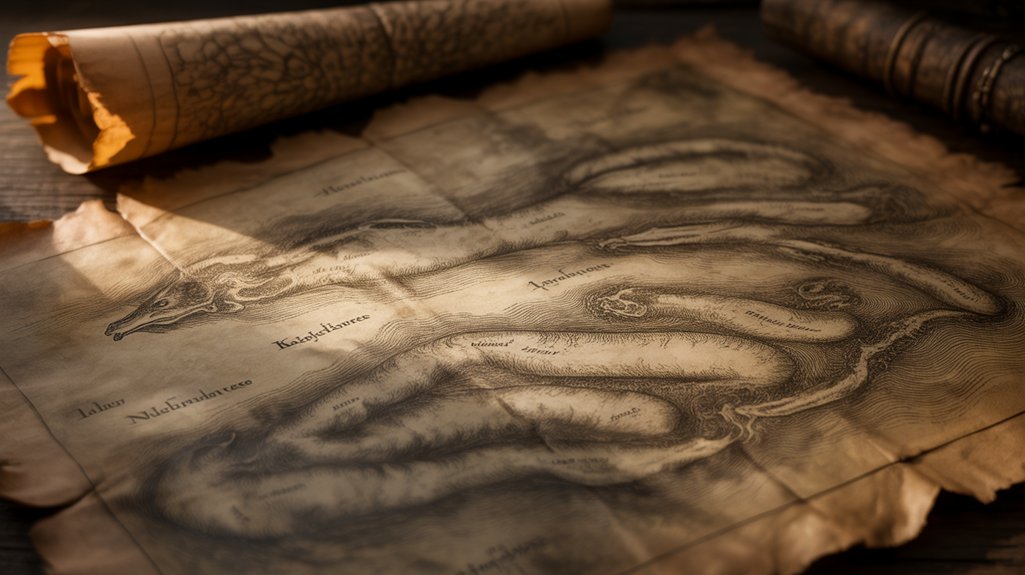
The kelpie claims dominion over Scotland's inland waterways—lochs, rivers, and streams where fresh water runs deep and dark beneath overhanging alders and birches.
These eldritch shape-shifters patrol their territorial waters with singular possessiveness, drowning those who trespass upon their liminal domains.
The nuckelavee, conversely, haunts coastal margins where saltwater meets land—a chimeric horror emerging from the northern sea to devastate Orkney's shores.
Habitat preferences reveal their fundamental natures:
- You'll find kelpies lurking beneath still surfaces, waiting in patient ambush where reflection masks reality.
- The nuckelavee roams freely across open coastlines, no boundary constraining its malevolent rampage through your settlements.
- Kelpies defend fixed territories; the nuckelavee claims entire islands as hunting grounds.
The kelpie respects borders, however deadly.
The nuckelavee recognizes none.
One offers deceptive beauty within confined spaces; the other brings unrestrained pestilence across expansive territorial waters.
Freedom means understanding which demon you face—and where.
Methods of Attacking Humans
Understanding the predatory methodologies of these eldritch entities reveals the fundamental divergence in their malevolent natures—where the kelpie employs cunning subterfuge to entice victims into its watery domain, the nuckelavee manifests as a chimeric harbinger of direct devastation.
You'll find the kelpie's approach alters seduction into annihilation, its beautiful equine form betraying those who dare mount its slick back, while the nuckelavee requires no deception, spreading contagion and wielding brute force as it emerges from the sea's edge.
These contrasting assault patterns, documented throughout Orcadian and Highland folklore since at least the sixteenth century, distinguish mere drowning from apocalyptic plague.
Luring Victims to Water
Both creatures employ adhesive enchantments—their most notorious shared characteristic—though each manifests this predatory magic through distinctly different corporeal forms and psychological strategies.
The kelpie's luring techniques center on deception. It assumes equine beauty, standing near lochs with glistening coat and gentle demeanor. You'd approach freely, touching its flank—trapped instantly by skin-bonding sorcery.
The nuckelavee requires no such subterfuge; this eldritch abomination drives victims toward water traps through sheer terror, its skinless form contaminating air itself.
Three ways these beings strip your autonomy:
- Supernatural adhesion prevents escape once contact occurs
- Environmental manipulation alters familiar landscapes into killing grounds
- Psychological warfare exploits your natural responses—curiosity or panic
Neither entity respects human agency. Both demonstrate how Scottish folklore's chimeric horrors convert water from life-source into death-boundary.
Physical Assault Techniques
Visceral dismemberment defines the nuckelavee's preferred methodology, while the kelpie employs drowning augmented by consumption—two approaches that reveal fundamental differences in how these entities conceptualize human flesh.
You'll encounter the kelpie's adhesive hide during aquatic ambushes, its chimeric body trapping riders beneath freezing currents where water-based combat proves futile. The creature tears prey limb from limb, savoring flesh in methodical fashion.
The nuckelavee eschews such intimacy. Its eldritch form spreads pestilence through breath alone, skinless muscles rippling as it tramples victims into earth and sea.
No drowning here—only crushing hooves and toxic exhalations that liquify organs before death arrives.
Both demons understand terrain supremacy. The kelpie manipulates depth and current; the nuckelavee dominates coastal boundaries where land surrenders to brine.
Disease and Pestilence Spreading
When examining pathogenic warfare as supernatural strategy, the nuckelavee emerges as Scotland's preeminent biological agent—a creature whose very existence constitutes an epidemic vector.
You'll find no pestilence myths more visceral in Orcadian tradition. This eldritch horror's breath alone wilts crops, poisons livestock, and spreads mortality across entire settlements. Disease transmission occurs through atmospheric contamination—the creature's exhalations carry contagion that respects no boundary.
The nuckelavee's pestilential arsenal includes:
- Mortasheen breath that inflicts livestock epidemics, destroying your livelihood and food security
- Crop blight emanating from its skinless form, condemning communities to starvation
- Watercourse contamination through bodily contact, poisoning your drinking sources
The kelpie, conversely, lacks pathogenic capabilities entirely. It's a predator, not a plague-bearer.
This distinction separates mere danger from existential threat.
Supernatural Powers and Capabilities
As creatures born from the turbulent waters of Scottish lore, the kelpie and nuckelavee manifest supernatural abilities that reflect their respective domains—one a shapeshifting predator of lochs and rivers, the other an apocalyptic horror of the northern seas.
The kelpie's demon characteristics center on metamorphosis. You'll find it assuming equine form, sometimes manifesting as a beautiful horse that lures travelers onto its adhesive hide. Once mounted, you're trapped—dragged beneath dark waters to drown. Some accounts document human disguises, allowing these entities to seduce victims through charm rather than force.
The kelpie's adhesive hide traps unwary riders, binding them irrevocably before dragging their victims into watery graves below.
The nuckelavee's supernatural abilities prove more catastrophically elemental. This chimeric abomination spreads blight across crops, poisons livestock with its toxic breath, and withers vegetation through mere proximity.
Unlike the kelpie's targeted predation, the nuckelavee devastates entire communities. Its eldritch presence corrupts the boundary between sea and land, flesh and decay—a walking pestilence that requires no shapeshifting subterfuge, only raw malevolence manifested in skinless, terrible form.
Weaknesses and Protective Measures Against Each Creature
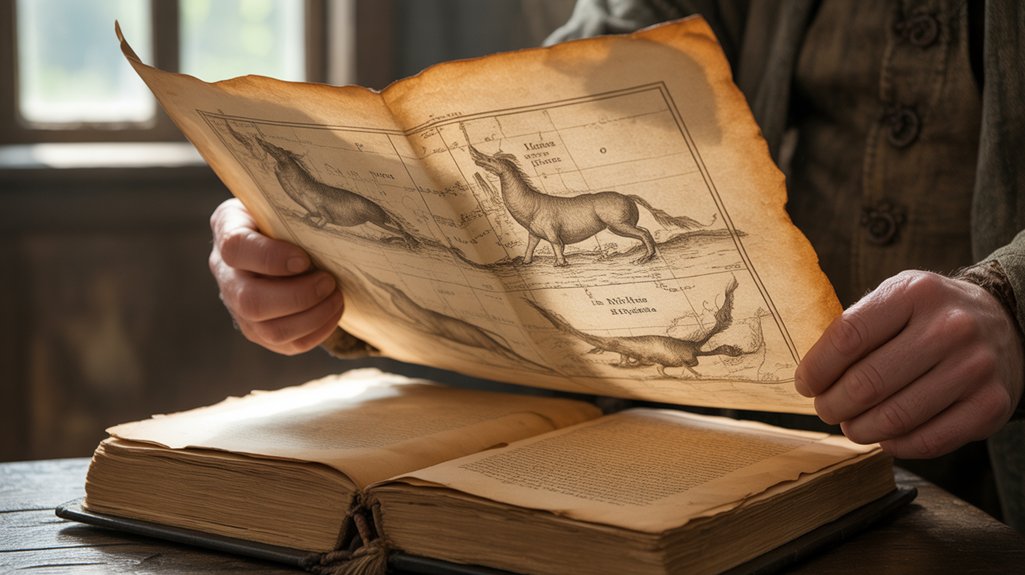
Despite their formidable supernatural arsenals, both creatures harbor vulnerabilities rooted in Scotland's protective folk traditions—weaknesses you'll find documented across centuries of cautionary tales and survival lore.
Protection strategies against these eldritch entities:
- The Kelpie's bridle vulnerability—capturing its chimeric form requires seizing the enchanted bridle, altering this shape-shifter into your obedient servant, bound by ancient laws governing faerie compacts and obligations.
- Fresh water's sanctifying power—the Nuckelavee can't cross running streams or freshwater boundaries, rendering you safe beyond these liquid thresholds that demarcate the terrestrial from the marine.
- Invocation of the Mither o' the Sea—this primordial deity constrains the Nuckelavee during summer months, offering you seasonal reprieve through her maternal governance over Orcadian waters.
These folklore remedies represent humanity's accumulated wisdom against supernatural predation.
Salt for Kelpies.
Distance for Nuckelavees.
Knowledge remains your ultimate shield, altering vulnerability into sovereignty through understanding these creatures' cosmological limitations.
Cultural Significance and Symbolic Meanings
Beyond their monstrous anatomies and folkloric countermeasures, these water-bound entities embody Scotland's deepest anxieties about the natural world—its beauty, its treachery, its capacity for swift annihilation.
The kelpie's cultural symbolism centers on seduction and betrayal. You'll find its mythological significance in Scotland's relationship with inland waters—those deceptive lochs where still surfaces conceal drowning depths. It represents temptation's fatal allure, the chimeric nature of appearances, how desire leads you astray.
The nuckelavee embodies something darker. Pure malevolence. This eldritch horror channels collective dread of famine, plague, drought—catastrophes beyond human control. Orcadian fishermen recognized its mythological significance as nature's wrath personified, the ecosystem's capacity for vengeance when disrespected.
Both creatures taught essential truths: water demands respect, beauty masks danger, the land possesses agency. They're moral anchors disguised as monsters. Cultural symbolism altered environmental hazards into narrative warnings, giving communities frameworks for understanding loss.
These weren't mere stories—they were survival compressed into myth.
Notable Legends and Historical Accounts
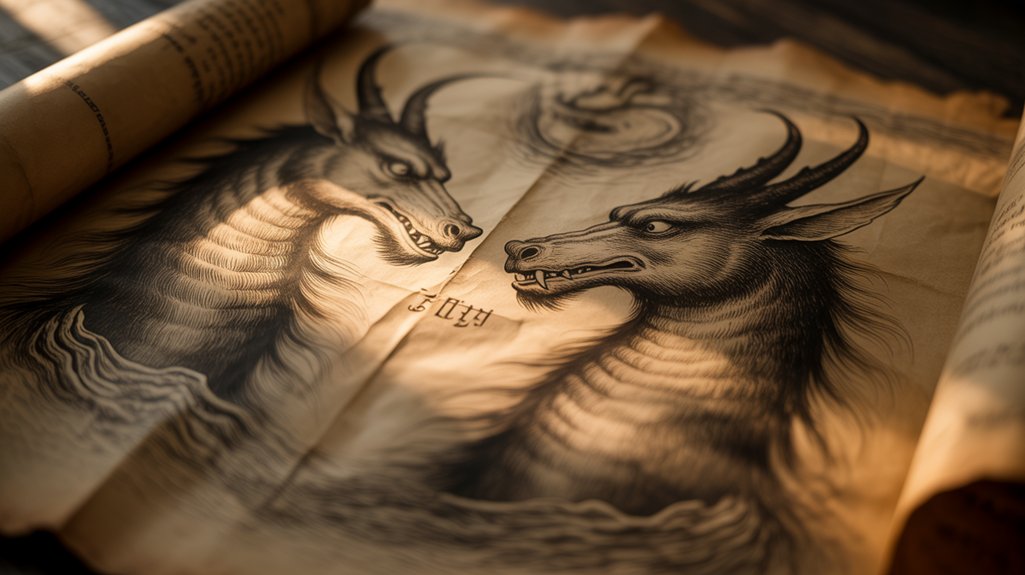
You'll find that documented encounters with these eldritch beings stretch across centuries of Scottish oral tradition and written accounts, each testimony bearing the weight of genuine terror.
The kelpie's shapeshifting nature generated countless regional variations—from the Aberdeenshire tales of cunningly disguised horses luring children to watery graves in the 1700s, to the chimeric beast that allegedly haunted Loch Ness long before modern monster legends took root.
The nuckelavee, conversely, terrorized Orkney with such concentrated malevolence that islanders recorded specific incidents: the 1830s plague attributed to its pestilent breath, the blighted harvests following its emergence from winter seas, the fisherman who barely escaped its skeletal grasp and lived to document the creature's sulfurous stench.
Famous Kelpie Sightings
Throughout the misty glens and lochs of Scotland, documented encounters with kelpies have persisted from medieval chronicles through the Victorian era, weaving themselves into the historical record with unsettling consistency.
These famous sightings represent more than mere folklore—they're testimonies of freedom-seeking souls who witnessed the eldritch:
- Loch Ness, 1527: A traveler recorded watching a chimeric horse emerge from dark waters, its hide dripping with phosphorescent algae, before vanishing into foam and shadow.
- Aberdeenshire, 1669: Nine children reportedly touched a “tame” stallion by the river's edge. Only one escaped, her testimony preserving the legendary encounter.
- Trossachs, 1870: A shepherd described encountering a supernatural equine whose eyes burned with ancient intelligence—predatory, knowing.
Each account challenges rationalist boundaries, demanding acknowledgment of mysteries beyond conventional understanding.
Nuckelavee Terror Tales
While kelpies haunt Scotland's inland waterways with their shape-shifting deception, the Nuckelavee emerges from Orkney's storm-wracked seas as something far more visceral—a skinless abomination that defies the natural order itself.
You'll find Nuckelavee myths concentrated in Orcadian folklore, where this chimeric horror combines equine and humanoid forms without concealing flesh.
Historical Nuckelavee encounters document catastrophic consequences: crop failures, livestock epidemics, drought. The creature's breath alone brings pestilence.
One documented account from the 1890s describes a man fleeing the demon across coastal rocks, saved only by crossing fresh water—the entity's singular weakness. The Nuckelavee couldn't pursue.
These terror tales reveal something deeper than mere monster stories. They're warnings.
The Orcadians understood forces beyond human control, eldritch powers demanding respect. You're witnessing recorded testimony of environmental catastrophe personified.
Influence on Modern Scottish Culture and Media
Both creatures have surged from Scotland's murky lochs into the nation's contemporary artistic consciousness, their eldritch forms reshaping themselves across literature, film, visual arts, and tourism industries with remarkable tenacity.
Scotland's water demons have metamorphosed into cultural currency, their supernatural menace now commodified yet undiminished across contemporary artistic landscapes.
You'll discover Kelpie symbolism woven throughout graphic novels, indie horror films, and sculptural installations that dot the Highlands—most prominently the thirty-meter Kelpies of Falkirk, towering steel monuments erected in 2013.
Nuckelavee adaptations, though rarer, infiltrate darker fantasy gaming universes and experimental theatre productions exploring ecological collapse.
Modern manifestations that preserve ancestral dread:
- Literary resurrections in Neil Gaiman's works and Scottish YA fiction reclaim these entities as symbols of untamed landscapes resisting colonization.
- Tourism ventures commodify folklore while paradoxically keeping oral traditions alive through guided storytelling tours.
- Environmental activism employs both demons as mascots for water pollution campaigns, their chimeric horror representing humanity's ecological sins.
These ancient predators refuse domestication, demanding you confront Scotland's uncompromising relationship with its liminal waterscapes.
Frequently Asked Questions
Can a Kelpie and Nuckelavee Fight Each Other?
You'll find no documented accounts of such a mythical battle in Scottish folklore, though their creature strengths suggest fascinating possibilities.
The kelpie's shapeshifting prowess and aquatic dominion contrast sharply with the nuckelavee's eldritch toxicity and terrestrial reach.
Both entities inhabit distinct ecological niches—the kelpie haunts freshwater lochs while the nuckelavee patrols coastal margins.
These territorial boundaries, deeply embedded in Orcadian and Highland traditions, suggest they'd rarely encounter one another, maintaining separate dominions within Scotland's liminal waterscapes.
Which Creature Is More Dangerous to Humans?
The nuckelavee poses graver peril to your mortal existence.
While kelpie behavior involves enticing victims through shapeshifting seduction—luring the unwary onto their backs before drowning them—the nuckelavee's habitat encompasses both terrestrial and aquatic domains, amplifying its eldritch threat.
This chimeric horror breathes pestilence, withers crops through proximity alone, spreads epidemic devastation across coastal settlements.
You'll find no bargaining, no escape from its skinless malevolence.
The kelpie offers deceptive choice; the nuckelavee grants only suffering, inexorable annihilation.
Are There Any Recorded Survivors of Nuckelavee Attacks?
You'll find scant Survivor accounts in Orcadian tradition—those who glimpsed the chimeric nuckelavee rarely lived to chronicle their terror.
The creature's pestilential breath alone proved fatal. However, fragments exist: fishermen who escaped by crossing fresh water, the eldritch boundary it couldn't traverse.
One 19th-century account describes a man fleeing seaward, his skin blistering from the demon's exhalations.
These Nuckelavee encounters end abruptly, testimonies incomplete—survivors died shortly after, organs failing, minds shattered.
Do Kelpies and Nuckelavees Interact With Other Scottish Mythical Creatures?
Like threads in a tapestry woven from Highland mist, these entities rarely cross paths with Scotland's broader pantheon.
You'll find kelpie alliances remain elusive—they're solitary predators who occasionally acknowledge other water-dwelling fae.
Nuckelavee rivals include the Seelie Court and sea-maidens who oppose its pestilential nature.
The creature's eldritch malevolence isolates it from most supernatural beings.
Neither demon truly collaborates; they exist as chimeric forces, untethered from the complex hierarchies governing brownies, selkies, and other Highland spirits.
Have There Been Any Modern-Day Sightings of Either Creature?
You'll find modern sightings remain remarkably scarce—these eldritch entities exist primarily within their folklore origins, rooted in Highland consciousness rather than contemporary eyewitness accounts.
Occasional reports surface from remote lochs, whispered testimonies of horse-shaped shadows. Yet serious cryptozoological investigation yields nothing substantial.
The nuckelavee, particularly chimeric in nature, hasn't manifested beyond Orcadian tradition since the nineteenth century.
These creatures dwell in liminal spaces between collective memory and ancestral warning, their power residing in cultural transmission, not physical encounter.
Conclusion
You've journeyed through Scotland's eldritch waterways, where kelpie and nuckelavee embody humanity's ancient terror of aquatic domains. Knowledge remains your truest armor—though neither creature strikes fear into modern hearts, their spectral presence endures in Celtic consciousness. These chimeric entities, born from maritime peril and agrarian dread, transcend mere folklore; they're cultural touchstones revealing how our ancestors grappled with nature's sublime ferocity. When all's said and done, you'll recognize these demons as Scotland's dark poetry made manifest.
